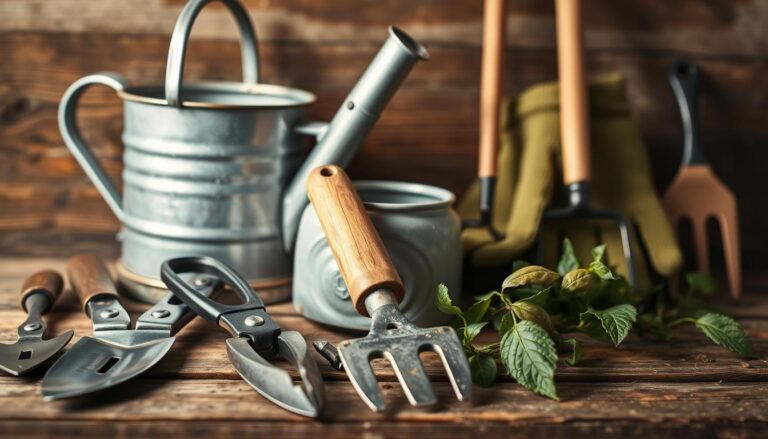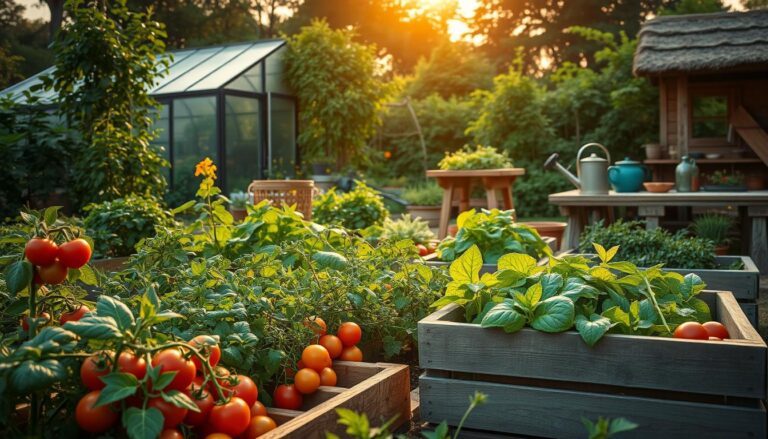To have year-round gardening success, you need to change your gardening ways with the seasons. You know the problems each season brings, from cold winters to hot summers.
Using gardening tips for each season keeps your garden lively all year. It doesn’t matter if you’re an expert or new to gardening. Knowing how to change your methods is crucial for a garden full of life and color every day.
With the right methods and planning, your garden can be a year-round haven. It will bring you joy and fresh food all the time.
Understanding the Gardening Calendar
Knowing the gardening calendar is crucial for a great garden. A good calendar keeps gardeners on schedule with seasonal tasks. This ensures the garden grows well all year.
The Importance of Timing in Garden Success
Timing is key in gardening. Planting at the right time can lead to a great harvest or a poor one. Gardening tips stress the need for timing, from planting seeds to harvesting crops.
How to Use USDA Hardiness Zones
The USDA Hardiness Zone map is a vital tool for gardeners. It helps you decide which plants are best for your area. It also guides you through seasonal changes.
Creating Your Personalized Garden Schedule
To succeed in gardening, make a personal schedule. Plan out tasks for the year, using garden care tips. Here’s a sample schedule:
| Season | Tasks |
|---|---|
| Spring | Plant seeds, prune trees, apply fertilizer |
| Summer | Water regularly, control pests, maintain garden beds |
| Fall | Harvest crops, prepare soil for winter, clean garden tools |
| Winter | Protect plants from frost, plan for next year’s garden, maintain garden structures |
By sticking to this schedule and using gardening tips, you can have a thriving garden all year.
Essential Tools and Supplies for Each Season
Seasonal gardening needs the right tools and supplies all year. Having the right equipment at the right time helps your garden thrive.
Must-Have Tools for Efficient Gardening
Every gardener needs basic tools to manage their garden well. You’ll need a trowel for planting, pruning shears for trimming, and a garden fork for turning over soil. Good quality tools save time and effort.
A wheelbarrow or garden cart is key for moving plants and supplies. A gardening kneeler or cushion makes gardening more comfortable.
Seasonal Supply Checklist
Each season needs different supplies. Spring calls for seeds, fertilizers, and pest control. Summer needs watering cans, irrigation systems, and heat-tolerant plants.
Autumn is for rakes, leaf bags, and compost bins. Winter requires frost protection, cold frames, and indoor growing lights.
- Spring: Seeds, fertilizers, pest control
- Summer: Watering cans, irrigation systems, heat-tolerant plants
- Autumn: Rakes, leaf bags, compost bins
- Winter: Frost protection, cold frames, indoor growing lights
Storage and Maintenance Tips
Keeping tools and supplies in good shape is key. Clean tools after each use and store them dry. Check tools often for damage and fix or replace as needed.
Store seeds and fertilizers in their original packaging. Keep them in a cool, dry place. This keeps them effective and fresh longer.
Spring Gardening: Awakening Your Garden
As winter fades, spring gardening brings a fresh start. It’s a key time to prepare your garden for a year of growth.
Soil Preparation and Amendment
Start by testing your soil. This tells you its pH level and nutrient content. Then, add compost or fertilizers to improve it.
Soil Testing: Use a soil testing kit to check your soil’s health. This helps you choose the right amendments.
Early Spring Planting Guide
Plant cool-weather veggies and flowers in early spring. Lettuce, spinach, and peas do well in cooler temps.
- Lettuce and other leafy greens
- Peas and other cool-season legumes
- Radishes and other root vegetables
Managing Spring Pests and Diseases
Spring brings pests and diseases. Spotting them early and managing them is crucial.
Common Spring Garden Problems
Aphids, slugs, and fungal diseases are common. Knowing these issues helps you tackle them.
Organic Solutions for Spring Challenges
Organic gardening has great solutions. Beneficial insects or neem oil can control pests without harming the environment.
| Pest/Disease | Organic Solution |
|---|---|
| Aphids | Neem oil or insecticidal soap |
| Slugs | Copper tape or beer traps |
| Fungal Diseases | Remove infected areas; improve air circulation |
Spring Tasks for Different Garden Types
Different gardens need different care in spring. Knowing these needs is key to a successful season.
Vegetable Gardens in Spring
Start seeds indoors or directly in the garden for veggies. It depends on the variety.
Flower Beds and Ornamentals
Flower beds need pruning, dividing, and new plants. Spring bulbs will add color to your garden.
Summer Gardening: Nurturing Growth
A successful summer garden needs special care. As it gets hotter, gardens need extra attention to grow well.
Watering Strategies During Hot Months
Watering right is key in summer. Deep watering helps roots grow strong, making plants drought-resistant. Watering in the early morning or evening helps avoid losing water to evaporation.
Drip irrigation systems and soaker hoses save water. They deliver water straight to the roots.
Summer Pruning and Maintenance
Summer pruning removes dead or damaged branches. This stops disease and promotes healthy growth. It also lets air and sunlight reach plants better.
Regular upkeep, like weeding and pest checks, keeps the garden healthy.
Heat-Resistant Plants and Techniques
Picking heat-resistant plants is wise for summer gardens. Succulents and plants that don’t need much water do well in the heat.
Drought-Tolerant Gardening Approaches
Drought-tolerant gardening means picking plants that like dry soil. Using mulch helps keep soil moist.
Creating Shade for Sensitive Plants
For plants that can’t handle too much heat, shade helps. Use shade cloth or plant tall plants to create natural shade.
Regional Summer Gardening Considerations
Gardening tips change with the region. Climate and soil differ, affecting how to garden.
Southern Gardens
In the south, focus on heat-tolerant plants. Also, manage humidity to prevent fungal diseases.
Northern and Coastal Gardens
Northern and coastal gardens face cooler temperatures and salt winds. Choose plants that can handle these conditions.
Fall Gardening: Harvesting and Preparing
Fall gardening is a key time to enjoy your garden’s hard work. It’s also a chance to get ready for next year. Gardeners need to adjust their plans to get the most from their harvest.
Fall Harvest Techniques
Harvesting in fall is more than just picking ripe fruits and veggies. It’s about knowing when to pick for the best taste and texture. For example, root veggies taste sweeter after the first frost.
Tips for harvesting: Keep an eye on your crops, use the right tools, and think about preserving. This way, you can enjoy your harvest all year.
Preparing Beds for Winter
As the growing season ends, it’s time to get your garden ready for winter. Clear out debris, add compost, and protect the soil from erosion.
- Remove weeds and debris to prevent pests.
- Add compost or manure to enrich the soil.
- Consider cover cropping to protect and enhance the soil.
Fall Planting for Spring Success
Fall is a great time to plant for spring. You can plant bulbs, perennials, and some veggies that do well in cooler weather.
Bulbs and Perennials for Fall Planting
Planting bulbs like tulips and daffodils in fall helps them grow strong before winter. Perennials like coneflowers and black-eyed Susans also get a head start.
Cover Crops and Soil Protection
Cover crops protect the soil over winter. They prevent erosion, control weeds, and add nutrients in spring.
Extending the Growing Season
There are ways to keep growing into fall. Use techniques to protect your crops from frost and cold.
Cold Frames and Row Covers
Cold frames and row covers help extend the growing season. Cold frames act like mini-greenhouses. Row covers keep frost off.
Fall Vegetables for Late Harvests
Vegetables like kale, spinach, and Brussels sprouts can be harvested late into fall. With protection, you can even get them in early winter.
By using these strategies, gardeners can enjoy a rich harvest. They also prepare their gardens for success in the future.
Winter Gardening: Rest and Planning
Winter is not just a time for gardens to rest. It’s also a key period for planning and getting ready. Gardeners can do many things during these cold months to make their garden healthy and vibrant in the spring.
Indoor Gardening Projects
Starting indoor gardening projects is a joy of winter gardening. You can begin seeds for early spring plants, force bulbs indoors, or keep a small herb garden inside. These projects give you a sense of achievement and a head start on the gardening season.
Winter Protection for Perennials
It’s important to protect perennials from the cold winter. Mulching, covering with burlap, or moving potted plants to a safe place can help. This care ensures your perennials will bloom again in the spring.
Planning Next Year’s Garden
Winter is the perfect time to plan your garden for next year. This includes seed ordering strategies and deciding on garden layouts and rotations. Planning ahead helps create a diverse and thriving garden.
Seed Ordering Strategies
When ordering seeds, think about the plants that did well last season and new ones you want to try. It’s wise to buy from trusted suppliers to get good seeds.
Garden Layout and Rotation Planning
Planning your garden layout and rotation is key for healthy soil and fewer pests. Think about crop rotation and companion planting to make a balanced garden ecosystem.
Winter Maintenance for Tools and Structures
Finally, winter is a great time to take care of your gardening tools and structures. Clean, sharpen, and store tools right, and check garden structures for damage. This keeps them in good shape for when spring comes.
Seasonal Gardening Tips for All Year-Round Success
To keep your garden thriving all year, you need a plan. This plan should include ways to handle the weather, smart planting, and keeping track of your garden’s progress. With these strategies, your garden will be beautiful and productive all year long.
Adapting to Climate Change Challenges
Climate change makes gardening harder, with wild weather and more extreme events. To deal with this, you need to be flexible and change your gardening ways. Pick plants that can handle the weather, protect your plants, and keep up with local weather trends.
Succession Planting for Continuous Harvests
Succession planting means planting small groups of seeds often. This method keeps your garden full of fresh food and lowers the chance of losing crops. By planting at different times, you get a steady flow of produce all season.
Record-Keeping for Garden Improvement
Keeping detailed records of your gardening is key to getting better. These records help you see what works and what doesn’t, and guide your future gardening.
Sustainable Practices Throughout the Seasons
For a garden that’s healthy all year, use sustainable gardening. This includes composting, improving the soil, and saving water.
Composting and Soil Building
Composting makes your soil better, helping plants grow strong. By turning organic waste into compost, you make your soil rich and fertile all year.
Water is precious, especially in dry areas. Mulching, drip irrigation, and catching rainwater help save water. This ensures your plants get the water they need without wasting it.
By using these tips, your garden will thrive all year. It will be productive and beautiful, no matter the season.
Specialized Gardening Techniques by Season
To have a garden all year, you need special techniques for each season. These methods help your garden grow well and look great all the time.
Container Gardening Through the Seasons
Container gardening is flexible and works for any season. In spring, fill containers with colorful flowers and early veggies. Summer is for warm plants like tomatoes and peppers.
For fall, use containers for cool crops like kale and spinach. In winter, add festive touches with evergreen branches or citrus trees.
Raised Bed Seasonal Strategies
Raised beds help with drainage and warm the soil, perfect for spring. They’re great for many veggies and flowers in summer.
Change raised beds for fall and winter crops. This keeps your garden growing all year.
Vertical Gardening Year-Round
Vertical gardening saves space and works all year. It’s great for spring and summer vines like peas and cucumbers.
In cooler months, it’s perfect for leafy greens and herbs.
Herb Gardens in Every Season
Herb gardens are year-round, with different herbs for each season. Spring and summer are for basil and mint.
Fall and winter are for rosemary and thyme.
Native Plant Gardening for Regional Success
Gardening with native plants is easy and good for the planet. These plants need less water and care because they’re made for your area.
Choosing native plants for each season makes a strong and beautiful garden.
Using these special gardening methods, you can have a diverse and productive garden all year. As “The right technique at the right time” becomes your guide, your garden will thrive in every season.
Conclusion
Year-round gardening success comes from adapting to the seasons. Knowing your local gardening calendar and using the right tools are key. With seasonal tips, you can have a thriving garden all year.
Spring, summer, fall, and winter each offer unique gardening chances. By following this guide, you’ll learn to garden all year. Whether you’re new or experienced, being ready and flexible is crucial.
Adding seasonal tips to your routine makes gardening better and your outdoor space more beautiful. So, let’s get started and enjoy gardening!
FAQ
What are the most essential tools for seasonal gardening?
How do I determine the best plants for my region’s USDA Hardiness Zone?
What are some effective watering strategies for hot summer months?
How can I protect my perennials during the winter?
What is succession planting, and how can it benefit my garden?
How can I adapt my gardening practices to climate change challenges?
What are some sustainable gardening practices I can implement throughout the seasons?
How can I keep track of my gardening progress and plan for future seasons?

Sortemdia nasceu com o propósito de trazer alegria e oportunidades para todos por meio de sorteios gratuitos de prêmios incríveis. O site tem como missão oferecer experiências acessíveis, divertidas e justas para quem deseja concorrer a produtos, serviços e brindes sem pagar nada por isso. Acreditamos que a sorte pode bater à porta de qualquer pessoa — e no Sortemdia, ela pode chegar com apenas um clique.



